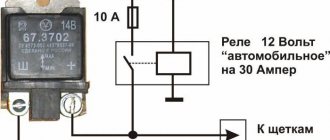In a car, the car's alternator is responsible for charging the battery. In fact, it is a device that is driven by a motor and converts mechanical energy into electrical energy. In turn, the car battery, spending part of its charge to start the engine and maintain power in the on-board network when the engine is turned off, needs active recharging.
If the system is working properly, the battery is recharged from the generator, and there is no undercharging or overcharging of the battery. However, during the operation of the car, problems may arise for a number of reasons. The result is that the battery fails. In this case, the “health” of the battery deteriorates in all cases (if the battery is very discharged, there is a constant discharge, if it is overcharged, the battery boils).
One way or another, in such a situation a diagnosis is necessary. Next, we will look at how much a car’s generator produces normally, why the generator does not charge the battery, for what reasons overcharging occurs, what voltage should be on the battery, etc.
How much should the generator produce to properly charge the battery?
Often, a car generator is not able to charge the battery on board the car to 100%.
And car owners don’t always know about this, and don’t even realize it. After all, a battery charged, for example, 70-80%, can also turn the starter and power the on-board network, although weaker and for less time than a fully charged one. To control battery charging from the generator, two quantities are used:
- Voltage (V, volts).
- Current, current strength (A, amperes).
Charging the battery in a car occurs only while the engine is running, when the generator rotates and generates electricity.
In this case, the battery should receive a voltage of 13.5V -14.5V.
The second most important parameter for charging is the current in amperes. This is where misunderstandings often occur. Initially, the battery and generator on the car are selected appropriately from the factory. At the factory, they install a battery of the exact capacity that can be fully charged by the standard alternator on this car model. But if the car owner then installed a new battery of a different capacity during the change, there may be inconsistencies.
NET.Gadget
Articles
How to check amps with a multimeter? annotation
A multimeter is a device that is used to measure voltage, current, resistance, and test wires. In other words, this device is quite necessary. With all this, as practice shows, it is quite popular not only in the industry, but also in everyday life.
Alas, once a competent installation is carried out and how to proceed with the necessary measurements, it should be taken into account that a multimeter. Not a completely safe device. If used incorrectly, of course, it will not only simply disable it, but also cause severe harm to one’s own health. This is especially true in cases where your company needs to take measurements at high voltage or high current. It won't be difficult to just immediately burn the multimeter and get severe electrical injury.
That’s why, before you can properly install and start using a multimeter, you need to practice on power sources with low current ratings, for example, batteries. It is also not recommended to misuse the instructions for the device.
Types of multimeters
First you need to know that multimeters are digital and analog (pointer, even among electricians they are known as “tseshka”). The latter have been known to electricians for a long time, but it is quite difficult to use them without special knowledge and practice.
- you need to be able to understand the scales of the device, of which there are several on the dial multimeter;
- The device should be kept in a position where the needle on it will not “walk” along the scale.
That's why, if possible, it is better to use a digital multimeter. We will also consider examples with the implementation of a specifically digital device, because it is quite difficult to learn how to work with analog multimeters without the help of others.
There are quite a few varieties of digital multimeters, but the principle of their operation is similar to each other - the difference lies solely in the number of functions of the device. Accordingly, the cost also depends on the functionality of the multimeter, so before you get it, decide why you need it.
The multimeter consists of:
- the device itself;
- 2 probes (dark and reddish);
- power source (9 V Krona battery).
So, what are the features of using this measuring device and how?
Instructions
In order to measure the current in a circuit, you need to connect the device to it one by one. With all this, on the multimeter itself you need to plug a reddish-colored probe into the socket on the device labeled mA, and a dark one into com. A serial connection means that the circuit must be broken and each probe is connected to a different wire, i.e. the device must be connected between 2 power sources. But because you are measuring current strength, and this is simply impossible to do in power supplies, you need to include a certain device in the circuit, for example an ordinary light bulb, placing it in the circuit immediately after the power source.
How can you simply check your charger
multimeter. Watch my other videos from the useful category.
How much should the generator produce to properly charge the battery?
The balance of the battery and generator is determined by the simplest formula. The number of amps/hours of the battery is divided by 10.
For example, a car is equipped with a battery with a capacity of 100Ah. 100:10 = 10A. For a battery with a capacity of 60Ah, this figure is 6A. (60:10=6).
This is exactly the amount of current the generator must provide to recharge these batteries. For a battery with a capacity of 100Ah – 10 amperes, for a battery with a capacity of 60Ah – 6 amperes, and so on.
It is important that this ratio is relevant for charging with a generator during a trip. The charger can charge a battery removed from the car even at a current strength that is 2 times less.
For example, 3A instead of 6A for a 60Ah battery. But charging will occur twice as slow; during a trip with high energy consumption (light, climate control), the battery may simply not have time to charge. Modern chargers themselves determine the parameters of the charging current; the capabilities of the 220V network for such purposes are not limited, unlike a generator. In rare cases, the charger only has a switch for the required voltage - for batteries of 6, 12 and 24V.
Most often, a car is equipped with a battery with a larger capacity than the standard one. A battery with a smaller capacity may simply not pull the starter even when fully charged, especially in the cold season.
The dimensions of the installation site often allow this to be done, since the dimensions of batteries of different capacities sometimes differ slightly.
For example, a battery with a capacity of 72Ah has dimensions of 27.8 cm by 17.5 cm by 17.5 cm. And a battery with a capacity of 100Ah has dimensions of 35.3 cm by 17.5 cm by 19.0 cm.
The differences in the sizes of batteries with a smaller difference in capacity (70-80Ah) are almost imperceptible, or they are sometimes equal, so such replacements happen quite often.
When making such a replacement, you should check the current strength of the generator. It can be indicated in the Operating Instructions, in the technical specifications section. Also, the actual current strength can be measured with the engine running using a simple ammeter or multimeter. Such measurements of current and voltage may be required not only when replacing the battery with a more powerful one. They evaluate the generator's performance in any case. Sometimes it can work, but not to its full potential. For example, the belt slips, low speed, little energy, the battery is recharged, but not completely.
In critical cases, when the generator is completely out of order, the car owner will notice this very quickly. Firstly, according to the signal from the devices, “the battery is not charging,” etc. Secondly, because after a short distance “on one battery” the car will quickly stop.
But chronic “undercharging” can go unnoticed.
Reduced tension in winter: what causes it?
Sometimes car owners are faced with a situation where, during the cold season, the battery parameters deteriorate and the car cannot be started.
To avoid problems, prudent drivers remove the power source and take it to a warm place.
In fact, the essence of the problems is as follows. When the temperature drops below “zero”, the density of the electrolyte also changes. Consequently, the voltage level is also adjusted (as noted above).
Even with normal charging of the battery, the density of the electrolyte increases, which is why U also increases. Therefore, if the battery is normally charged, it has nothing to fear.
The situation is worse if you leave a discharged battery in the cold. In this case, the density will drop and problems with starting the motor will appear. In some cases, the liquid may freeze.
As for the problems associated with starting a battery in the cold season, they arise due to the inhibition of chemical processes inside the device when the temperature drops below zero.
This means that with a normal charge, the density and voltage of the battery will be sufficient to start the engine even in winter.
Knowing what voltage should be on the car's generator, you can avoid premature failure or battery discharge, as well as timely diagnose a malfunction of the generator itself.
The service life of a car battery is not calculated by the years guaranteed by the manufacturer, but by the number of “discharge/charge” cycles. The more competently the operation and maintenance of the battery are organized, the less often you will have to buy a new one. The question of the voltage rating at the battery terminals worries many motorists.
Everyone knows what it should be “statically” - about 12.6 V. This is the norm. What is its value when the car engine is running? Will it change or not, and if so, in what direction? Let's figure this out.
If there are no complaints about the battery, then checking the voltage at its terminals with the engine running allows you to diagnose the generator. That is, to determine how correctly the latter functions, and in general, whether it provides charging or not.
No specialist will give a definite answer regarding the voltage level on a car battery. The main reason is that it is unknown what engine operating mode is intended and whether other consumers of electricity are included (or not). These include (who forgot) - headlights, lights with turn signals, a stove and a number of others, depending on the car model. The amount of charging current (and therefore the voltage on the battery) is partially influenced by air temperature. Few people take this into account, but it is this factor that leads to some scatter in the instrument readings.
Let's try to summarize all the data on battery voltage values (in V):
The car engine does not work
A good battery (read about its choice here) should have at least 12.4 on its terminals. The normal voltage is 12.5 - 13. A lower value indicates a high degree of discharge. Another reason is a decrease in capacity due to the onset of sulfation of the plates, for example. And this is already a “bell” for the owner of the car. Moreover, at voltage = 12 and below, starting the car is quite problematic, especially when cold weather sets in.
Engine running
The normal voltage is 13.5 - 14.
Exceeding the value (for example, up to 14.2) is a sign of severe battery discharge (read about charging rules here). In this case, the generator is forced to produce increased current. This is the main reason. For cars equipped with various electronics, there is a second one. Temperature sensors in a cold room can adjust the generator mode. The result is the same - increased voltage at the battery terminals.
A low voltage on the battery when the engine is running (less than 13) is evidence that the battery charging mode does not correspond to the norm. What could be the reasons?
Firstly, in the battery itself. Resource depletion and sulfation are the main problems that car owners most often encounter.
Secondly, either the generator is not working well, or there is a malfunction in the electrical circuit. For example, increased leakage current with decreased insulation resistance. As a rule, defects in the braiding of wires that lead to breakdown and short circuit.
Thirdly, there is a problem with contacts. This should be checked immediately. Remove the terminals, inspect them and the battery terminals for oxidation. If necessary, clean and tighten fasteners tightly.
How to check the voltage on the battery - watch the video:
Useful tips
- It is not advisable to use the capabilities of the on-board PC to measure the voltage on the battery. The result will differ from the true value due to the specifics of connecting the computer to the on-board network. Therefore, errors cannot be avoided. And approximate data, taking into account some variation in parameters, will tell the car owner little.
- This is how you can verify the normal operation of the generator and the good condition of the battery. Turn off all consumers and start the engine. The multimeter should show about 13.6±1. Then, one by one, one of the electrical network devices turns on. For example, headlights, then low beam. Each of the electrical devices “reduces” the voltage by 0.2. But in total - no less than 12.8. Otherwise the battery will drain quite quickly.
- Even if the battery meets all the described requirements, a comprehensive check should be carried out regularly. A good battery should “hold” voltage. If the car has not been used, and, for example, after a few days the multimeter shows a value significantly lower than in the previous test, then the battery is already “at its limit.” You need to be especially careful with her.
The author draws attention to the fact that all recommendations are rather approximate and generalized. But it is precisely these simple techniques that allow even inexperienced car owners to understand the condition of the battery, whether the generator is working and how correctly the battery is being recharged. For a more detailed study of all components of the on-board electrical network, you need to contact specialists.
How much should the generator produce to properly charge the battery under load?
The operating voltage of the vehicle's on-board network, regardless of the load and engine speed, respectively, of the generator, is from 12V to 14V. The generator and battery work in tandem as energy sources. If there is a lack of voltage and current in the network from the generator, the battery can compensate for it. When the battery is discharged, on the contrary, the generator can charge it.
At high and low generator speeds, different amounts of energy are produced. But a stable voltage is supplied to the network, since it is equalized by the diode bridges of the generator and relay regulators.
There is no big problem with voltage drops between 12V and 14V. By analogy with 220V networks: the voltage in them can fluctuate from 180V to 240V (± 10-15%), however, all household appliances, computers, etc. work, although up to certain levels of differences.
Source
How is a car battery charged from a generator?
When starting the car, the battery emits electric current and is discharged. When the car engine is running, the generator produces energy. The on-board electrical station of the car, when the rotor and stator windings interact, produces an alternating three-phase current. The resulting energy replenishes the battery and powers the vehicle's electrical system.
How does a car's energy system work?
The three-phase generator produces alternating current, and the power supply is designed for direct current. Therefore, through the rectifier, energy is supplied to the battery, and from there it is distributed to consumers. If the battery does not receive energy from the generator, it will run out and the car will lose power. The battery cannot be fully charged from the car's internal network. External recharging is required periodically.
How to check if the battery is charging from the generator
Before testing the functionality of the generator, you need to make sure that the battery is in good condition. If your car battery is not charging, checking your alternator may reveal mechanical and electrical problems. In VAZ cars, engine starting problems often occur when the generator does not charge the battery sufficiently.
Types of control over the operation of the device:
- Visual inspection. If the battery does not charge, you need to carefully inspect the wiring. Be sure to clean the oxidized contacts from the generator and tighten the connecting fasteners. It is necessary to inspect the battery case - when overcharging due to the fault of the gene, the rate of battery destruction increases. Symptoms: The battery will develop a permanent coating and the charging indicator will glow red.
- After repairing the car, it would be useful to check that the generator is connected correctly by rotation. We connect an anti-fog lamp to the outputs. We apply rotation to the rotor using a drill. If the light does not light up, you need to change the polarity of the connection.
- A working generator supplies a stable voltage of 14.1 - 14.5 V. You can measure the indicator on a bench. Diagnostics is carried out using a battery and a 50 W incandescent lamp. If the glow is bright, the generator is working. This means that the reasons why the car battery is not charging need to be looked deeper.
- Greater accuracy in finding problem areas will be obtained by testing the stator and rotor separately. They are looking for an interturn short circuit or a short circuit of individual wires to the body or a poor connection of the terminals with the contacts. A short circuit is often the reason when the battery of a VAZ car is not charged from the generator.
- Checking the diode bridge for the suitability of all diodes, 3 positive and 3 negative. If at least one of the diodes is broken, the battery will show a low charge.
- The Control Ind alarm can be a signal to check the power supply system. If the car's generator and battery are working properly, the reason why there is no charge may lie in a faulty voltage relay.
Will the battery be charged from the generator if there is damage that prevents the rotor from rotating? Mechanical problems include faults in which the rotor does not spin - a torn or loose timing belt, a crumbling bearing, and the like.
How long does it take to charge a battery from a generator?
The generator and battery must comply with the technical parameters. A full battery charge is enough for several attempts to start the engine with a break between turns of the starter. In this case, the battery does not receive recharge and may be completely discharged.
How long does it take for the car's alternator to charge the battery? Considering that energy replenishment should not be more than 10% of the battery capacity - quite a long time. The supplied energy is immediately used to recharge operating devices. And only the energy reserve replenishes the battery capacity. How long will it take for a battery that is dead when starting the engine to be charged from the generator?
If the power of the generator matches the capacity of the installed battery, the on-board power plant generates 10% of the energy from the battery capacity. How long does the drive need to charge? If its capacity is 60 A/h, then the generator must produce a current of 6 A, excluding consumers. Therefore, the generator power must be greater to compensate for losses, and service devices are selected comparable to the capabilities of the power unit.
If the battery is not charged from the generator, the reason may be a large number of consumption sources that can take up to 80 A. If the generator’s power is insufficient, or it is faulty, will the battery be charged from it? It is necessary to turn off some of the service equipment - media center, air conditioner and the like.
When is it time to change the battery and why?
Owners of Lada Kalina are well aware that replacing the battery is necessary after three to four years of active use. It all depends on various factors, for example, on the quality of the battery, on the energy consumption of the vehicle’s on-board network. But not everyone knows by what signs one can determine that it is time to think about a new battery for the Lada Kalina, because the specified period is determined conditionally. For this reason, everyone should understand when to change the battery to avoid problems associated with the inability to start the engine. Among the main signs indicating the need to replace the battery:
- The engine starts with difficulty not only in winter, but also in summer. This means that the power supply cannot hold a charge.
- The indicator lamp for the need to charge the battery lights up on the instrument panel. The on-board computer, if available, can also signal this.
- After a long trip (more than 15 km), a measurement with a multimeter shows insufficient charge. The device must be fully charged from the generator, if the latter is working.
- Once fully charged, the density measurement shows less than 1:25 Gm/cm. You can try to level the indicator with a corrective electrolyte; if this does not help, it is better to replace the battery.
- The electrolyte has darkened. This occurs due to the destruction of the lead plates. The use of such a battery is prohibited as it may cause an explosion.
- If the battery emits an unpleasant smell of putrefactive decomposition.
- You can turn on the radio for an hour with the engine off. If after this the engine starts with difficulty, this means that the battery is draining too quickly and it’s time to change it.
- If the battery lasts more than four years, then it's time to buy a new one.
If any of these symptoms occur, you may need to purchase a new power supply for your vehicle soon.
In some cases, you can extend the battery life by using corrective electrolyte and additional charging.
How long does it take to charge a car battery from a generator?
How long it takes to charge a car battery from a generator is an imperial indicator. It depends on the ease of starting - how many times the starter was turned. The remaining charge of the battery after a long period of parking varies, as do the temperature conditions. Therefore, restoration of battery capacity depends on the technical parameters of the generator, at what speed it produces current, and how many additional devices are powered.
However, it is known that in order to restore the battery’s ability to start the engine, you need to idle and drive at average speed for at least 20 minutes. To fully restore capacity, it will take at least 3 hours of continuous vehicle movement.
How long a battery is charged from a car generator depends on the ambient temperature and the condition of the battery. But as the electrolyte heats up, the chemical process proceeds faster and less external energy is required. How quickly the charge accumulation process occurs depends most on how long the generator operates. Therefore, on long-distance vehicles, batteries are rarely charged from the network.
Interesting facts from the operation of rechargeable batteries
How much does the starter consume in winter, what is the minimum voltage threshold for its operation and how many cranks can it make at -20°C before the battery runs out? How to assess the charge level of a battery using only a multimeter, and how often to use a charger? The magazine's experts talk about all this.
Battery and starter
The maximum starting current of the electric motor of the starter mechanism on front-wheel drive Ladas is no more than 400 A. In winter, as a rule, it comes to 350 A. In summer, less is required - about 200 A.
How much should the generator produce to properly charge the battery?
Constant undercharging of the battery or its absolute discharge at the most inopportune moment is a headache for many car owners. One source of these problems may be the generator. But how to check it? Perhaps it's not his fault at all? Let's figure out together how much the generator must produce for the normal functioning of all car systems and maintaining the battery in a charged state.
How to check the operation of the generator
The battery in a car is an important element of the system, which is responsible for providing the car’s on-board network with electricity. The generator is used to charge the battery while it is active. Unstable operation of a device generating electricity causes a voltage drop in the network and failure to restore the capacity of the power source.
Normal generator performance means timely and complete replenishment of the battery charge level, which decreases under load. Checking the battery charge level from the generator is simple and can be done by the car owner himself.
Diagnostics of an automotive energy-generating device includes a visual inspection of the unit, its elements and related parts, as well as voltage and current measurements. At least twice a year, you should check the tension of the drive belt, excessive weakening of which leads to a decrease in the performance of the generator, and sometimes can lead to breakdown of the device. Once a year, you can check equipment elements - fasteners, diode bridge, voltage regulator and others. Timely maintenance of the battery will also guarantee the absence of problems - cleaning the terminals, adding distilled water.
Diagnostics of indicators such as voltage, current, resistance are also necessary twice a year. To carry it out, you will need special devices - a voltmeter, multimeter or load fork.
What's the result?
Taking into account the above information, it becomes clear that if problems begin with the battery, often the cause of the problem is the generator, and not the battery. In this case, the generator needs to be checked comprehensively (alternator brushes, slip rings, windings, generator relays, wiring, terminals, etc.)
Please note that too high a load on the generator (for example, when installing powerful emergency power consumers) in many cases causes rapid failure of the generator. To avoid problems (especially when choosing a new generator), you need to separately take into account some features.
As a result, we add that every 15-20 thousand km. mileage, it is necessary to check the tension of the generator belt, since loosening it reduces the performance of the generating device. It is also necessary to periodically check the diode bridge, voltage regulator, as well as a number of other elements. At the same time, the terminals are cleaned and the battery is serviced. This approach will allow you to maintain full functionality of the system and eliminate possible unexpected breakdowns.
Source
Why 24 Volts?
In trucks and buses, to reduce too powerful currents, both generated by the generator and consumed by the starter, a voltage twice as high as in passenger cars is used. Increasing the voltage in the system by 2 times allows you to reduce the current by 2 times. And although the system is called 24 Volts, in reality, when the engine is running, the voltage produced by the generator is about 28-29 V. When the engine is off, the voltage is below 25.2-25.4 Volts.
In a 24V system, TWO 12V batteries are used, connected in series. If we approach the issue thoroughly, then one 12 V battery consists of 6 “2V” batteries connected in series. And in the case of a truck, 12 “2V” batteries are already connected in series. The problem is charging and discharging these batteries at the same time. All 12 battery cells are charged with a total voltage from the generator of 28.8 Volts (each of the twelve must have a charge voltage of 2.4 Volts). It's like feeding 12 kittens from the same bowl so that everyone eats the same amount.











